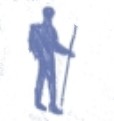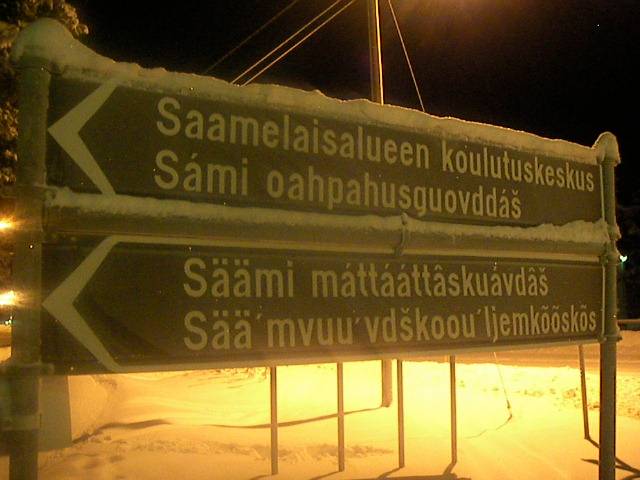Published in Resurgence & Ecologist
April 2009
There’s nothing at all unusual-looking about the school at Sevettijärvi. It may be half buried in snow, the lights of the classrooms blazing into the darkness of kaamos, or polar night, but that’s normal for remote Finnish Lapland at this time of year. Inside, it’s modern and well-equipped, and the students – though there are not many – look and act like any other group of kids.
You wouldn’t know to look at them, but these children stand in the front line of a struggle to save a language, and possibly a culture, from extinction. They are the youngest speakers of Skolt, one of the three minority languages spoken by Finland’s indigenous Sámi. Listed as ‘critically endangered’ in the UNESCO Red Book on Endangered Languages, Skolt Sámi is spoken by just 300 people, most in their old age.
‘When I was at this school, there were 100 students,’ says teacher Seija Sivertsen. ‘Now there are 11.’
The precipitous decline of Skolt mirrors the plight of minority languages across the world from Manx to Eyak, the Alaskan tongue whose last speaker passed away in 2008. Of course, languages have always gone extinct, just as biological species have. History is littered with the names of vanished tongues, from Carib to Etruscan. But languages now face an extinction crisis at a rate never witnessed before, a mass die-off surpassing even the decimation of the planet’s biodiversity. The UN estimates that one language disappears every fortnight, and that half the languages spoken today will vanish within the next century.
Luisa Maffi of Terralingua identifies two basic phenomena that lead to the erosion of linguistic diversity: long-term demographic trends (the spread of a dominant language and culture) and specific historical upheavals like war. The Skolt Sámi have been victims of both. Uprooted from their homeland in Russia and resettled in Finland during World War Two, they became a minority within a minority, practicing different customs and religion, suffering discrimination even more than other Sámi groups.
‘Not only the Finnish people, but the Northern Sámi and Inari Sámi always teased the Skolt at school,’ says Tiina Sanila, an activist and singer in a Skolt metal band. ‘They don’t want to be involved with the other Sámi now. If you see that your culture is not respected, that it’s ‘un-modern’ and disliked, it undermines the community’s self-confidence.’
Tiina is fighting this legacy today through music and through politics, struggling to make Skolt relevant to a younger generation. ‘If you lose your language, it is the worst form of subjugation. Sometimes it feels as if we have already lost everything.’
Unless something dramatic happens soon, Skolt Sámi – and its repository of traditional lore linking the displaced community back to its long-lost homeland – looks set to join the 50% of languages predicted to vanish by the end of the coming century.
An hour’s drive south on the Arctic Highway, following the vast frozen lake Inarijärvi, lies the tiny village of Inari. Again, it doesn’t look like much – a scattering of wooden cabins huddled under snow – but this is the centre of the Inari Sámi, who have subsisted here for thousands of years on fishing and limited reindeer herding. The Inari also suffered during and after the war. The dominant Finnish population viewed their culture as primitive and backward, and the speaking of indigenous languages was heavily discouraged in the young. An entire generation grew up feeling ashamed of its heritage – echoing the experience of indigenous people from Australia to the Americas – and parents ceased teaching the language to their children.
The Sámi call this the ‘lost generation,’ and speak of a traumatic loss of identity that imperilled the language’s chances for survival. Like Skolt, Inari is critically endangered, hovering at around 300 speakers. But while Skolt’s decline appears irreversible, Inari Sámi has in recent years remarkably bucked the trend. Through a pioneering ‘language nest’ programme launched by a handful of committed activists, the language is seemingly pulling itself back – child by child and speaker by speaker – from the brink.
Trudging through deep powder snow on a visit to the Sámi Radio offices – which broadcasts in all three Sámi tongues – I meet language activist Annika Pasanen, a Finn who’s been part of the Inari community for the past 20 years. Annika’s work involves the revitalisation of Finno-Ugric languages from Inari Sámi to Russia’s Karelian, minority cultures under similar pressure to assimilate and forget their heritage.
‘You have been told that you must be civilised, your language and culture is not important, it’s taboo, so you teach your children the dominant language,’ says Annika. ‘A kind of trauma has been caused. People feel ashamed of what they are. The language nest helps heal this trauma.’
The concept of the language nest is simple: a kindergarten in which only Inari Sámi is spoken, normalising children to their ancestors’ tongue from a very early age. It was launched in 1997 by a man called Matti Morottaja, who is spoken of with awe in these parts for his vision in revitalising the language when it appeared all was lost. Despite initial scepticism, a gradual growth in child speakers – the determining factor in a language’s survival – has kick-started Inari culture and effectively bridged the gulf that formed during the ‘lost generation.’
As with many indigenous tongues, the Sámi languages have evolved as vehicles for the transmission of highly specialised forms of knowledge, particularly in regards to the local ecosystem. In an environment as extreme as the Arctic Circle, this knowledge is particularly crucial. Sámi languages have 30 words for snow, and hundreds of words specific to the intricacies of reindeer herding, describing the animals’ age, size, colour, shapes of antlers, and even how they walk. If minority languages disappear, vital knowledge goes with them. But as Inari Sámi demonstrates, it isn’t enough for languages to remain fossilised, locked in the past. Amazingly, Inari is actually growing now; new words are constantly being coined as the lexicon expands to envelop new ideas and technologies, and even a recently-discovered species of mushroom.
‘Language has to change, otherwise it dies,’ says Annika. ‘Some older people think we must keep Sámi preserved as it is. It’s very important these attitudes do not dominate. If it’s kept in a museum, it cannot live.’
The proof that language death can be halted is good news for minorities worldwide, and the Sámi have forged contacts with indigenous groups in many other countries and continents. At Sevettijärvi school I notice the children are wearing green stone pendants, which turn out to be gifts from their headmistress from a recent trip to New Zealand, where she was researching language revitalisation amongst the Maori. Their presence in this land of snow and ice shows how different cultures can pool hard-won knowledge and experience to help them resist the great language die-off. As Tiina Sanila makes clear, once cultures lose their language they lose their confidence and self-respect, severely weakening their chances for survival in an increasingly globalised and homogenised world.
But the implications of language death reach far beyond isolated cultures, affecting even us majority-language speakers to whom the threat seems so remote it feels entirely abstract. Linguist K. David Harrison notes that if indigenous languages vanish, ‘so will important, long-cultivated knowledge that has guided human-environment interaction for millennia. We stand to lose the accumulated wisdom and observations of generations of people about the natural world … The sobering fact that both animal species and human languages are going extinct in tandem portends an impending loss of human knowledge on a scale not seen before.’
‘Without language, there are not memories,’ is one of the last things Annika says as I make my journey back through the snow. As humanity seemingly sleepwalks towards a future stripped of diversity – linguistic, cultural and biological – we will need all the memories and knowledge we collectively possess.


